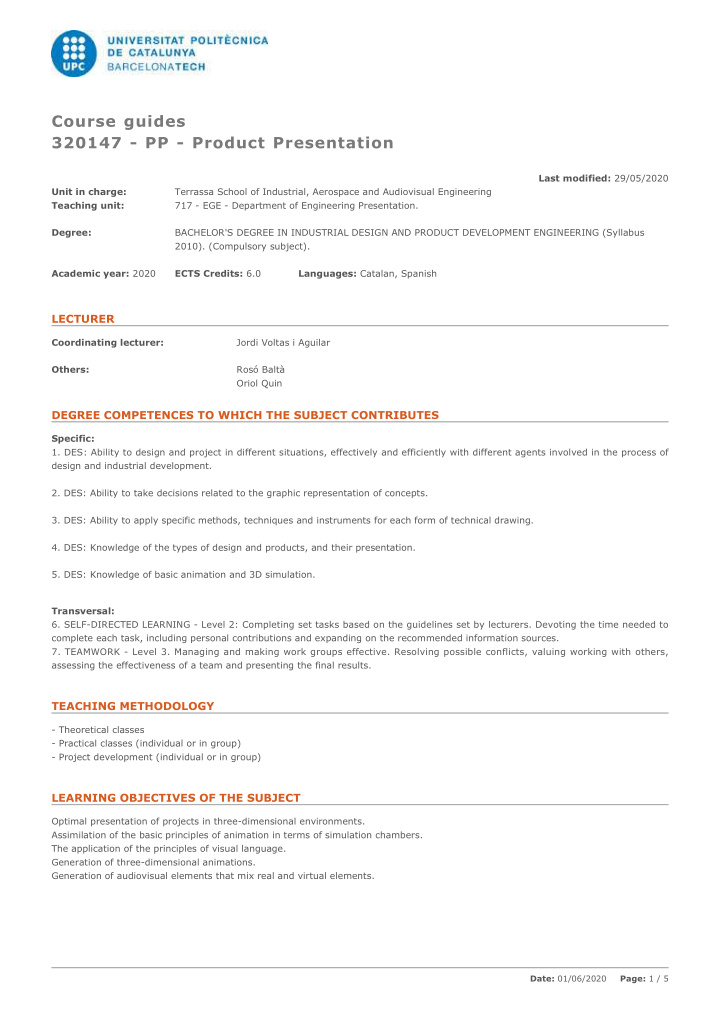



Course guides 320147 - PP - Product Presentation Last modified: 29/05/2020 Unit in charge: Terrassa School of Industrial, Aerospace and Audiovisual Engineering Teaching unit: 717 - EGE - Department of Engineering Presentation. Degree: BACHELOR'S DEGREE IN INDUSTRIAL DESIGN AND PRODUCT DEVELOPMENT ENGINEERING (Syllabus 2010). (Compulsory subject). Academic year: 2020 ECTS Credits: 6.0 Languages: Catalan, Spanish LECTURER Coordinating lecturer: Jordi Voltas i Aguilar Others: Rosó Baltà Oriol Quin DEGREE COMPETENCES TO WHICH THE SUBJECT CONTRIBUTES Specific: 1. DES: Ability to design and project in different situations, effectively and efficiently with different agents involved in the process of design and industrial development. 2. DES: Ability to take decisions related to the graphic representation of concepts. 3. DES: Ability to apply specific methods, techniques and instruments for each form of technical drawing. 4. DES: Knowledge of the types of design and products, and their presentation. 5. DES: Knowledge of basic animation and 3D simulation. Transversal: 6. SELF-DIRECTED LEARNING - Level 2: Completing set tasks based on the guidelines set by lecturers. Devoting the time needed to complete each task, including personal contributions and expanding on the recommended information sources. 7. TEAMWORK - Level 3. Managing and making work groups effective. Resolving possible conflicts, valuing working with others, assessing the effectiveness of a team and presenting the final results. TEACHING METHODOLOGY - Theoretical classes - Practical classes (individual or in group) - Project development (individual or in group) LEARNING OBJECTIVES OF THE SUBJECT Optimal presentation of projects in three-dimensional environments. Assimilation of the basic principles of animation in terms of simulation chambers. The application of the principles of visual language. Generation of three-dimensional animations. Generation of audiovisual elements that mix real and virtual elements. Date: 01/06/2020 Page: 1 / 5
STUDY LOAD Type Hours Percentage Hours large group 15,0 10.00 Hours small group 45,0 30.00 Self study 90,0 60.00 Total learning time: 150 h CONTENTS TOPIC 1: Principles of animation Description: 1.1. Fotorealistic environments 1.2. Virtual cameras 1.3. Rendering Related activities: Reading and analysis of sample material. Full-or-part-time: 10 h Laboratory classes: 4h Self study : 6h TOPIC 2: Global lighting models Description: 2.1. Lighting photon map based 2.2. Lighting image based (IBL) Specific objectives: Rendering using photon map systems Rendering using IBL systems Related activities: Reading and analysis of sample material Solving on concret exercices Layout of own proposals models. Full-or-part-time: 10 h Laboratory classes: 4h Self study : 6h Date: 01/06/2020 Page: 2 / 5
TOPIC 3: Textures Description: 3.1. Basic materials 3.2. Textures 3.2. Sample material collections 3.3. Unwrapping methods Specific objectives: Applying textures Using rendering engines Related activities: Reading and analysis of sample material Solving on concret exercices Layout of own proposals models. Full-or-part-time: 20 h Laboratory classes: 8h Self study : 12h TOPIC 4: Indor and outdoor scenes Description: 4.1. Outdoor lighting 4.2. Indoor lighting 4.3. Exposure compensation 4.4. Lighting day / night Specific objectives: Applying audiovisual standards on lights and cameras to producte presentation images of products. Related activities: Reading and analysis of sample material Solving on concret exercices Layout of own proposals models. Full-or-part-time: 20 h Laboratory classes: 8h Self study : 12h Date: 01/06/2020 Page: 3 / 5
(ENG) TEMA 5: Introduction at 3D Animation Description: 5.1. Animation by keyframe. 5.2. Dummies use 5.3. Animation curves edition 5.4. Parametric animation. 5.5. Camera animation. 5.6. Lights animation. Specific objectives: Setup of animation environemts Do 3d animations of products to be presented Related activities: Reading and analysis of sample material Solving on concret exercices Layout of own proposals models. Full-or-part-time: 20 h Laboratory classes: 8h Self study : 12h TEMA 6: Advances animation Description: 6.1. Particles animation 6.2. Fisics Specific objectives: Add realism at product presentations using particle animation and fisics. Related activities: Reading and analysis of sample material Solving on concret exercices Layout of own proposals models. Full-or-part-time: 20 h Laboratory classes: 8h Self study : 12h Date: 01/06/2020 Page: 4 / 5
TEMA 7: Integración Description: 7.1. Camera matching 7.2. Integration 7.3. Rendre elements 7.4. Editing and compositign Specific objectives: Mixing real and virtual models on product presentations Related activities: Reading and analysis of sample material Solving on concret exercices Layout of own proposals models. Full-or-part-time: 20 h Laboratory classes: 8h Self study : 12h GRADING SYSTEM The course is graded on the following areas: - Presentation of individual works - Presentation of projects - Theory 40% Exams 20% Exam 1 20% Exam 2 Practices and deliverables along course: 60% For those students who meet the requirements and submit to the reevaluation examination, the grade of the reevaluation exam will replace the grades of all the on-site written evaluation acts (tests, midterm and final exams) and the grades obtained during the course for lab practices, works, projects and presentations will be kept. If the final grade after reevaluation is lower than 5.0, it will replace the initial one only if it is higher. If the final grade after reevaluation is greater or equal to 5.0, the final grade of the subject will be pass 5.0. EXAMINATION RULES. Assistance at practices is compulsory. The evaluation methodology will be: - Questionnaires - Evaluation of all the deliveries - Correction process and participation by students BIBLIOGRAPHY Basic: - Brooker, Darren. Essential CG lighting techniques with 3ds Max. 3rd ed.. Oxford: Focal Press Elsevier, 2008. ISBN 9780240521176. - Eissen, Koos; Steur, Roselien. Sketching product design presentation. Amsterdam: BIS Publishers, 2014. ISBN 9789063693299. - Robertson, Scott; Bertling, Thomas. How to render: the fundamentals of light, shadow and reflectivity. Culver City, CA: Design Studio Press, 2014. ISBN 9781933492964. Date: 01/06/2020 Page: 5 / 5
Recommend
More recommend